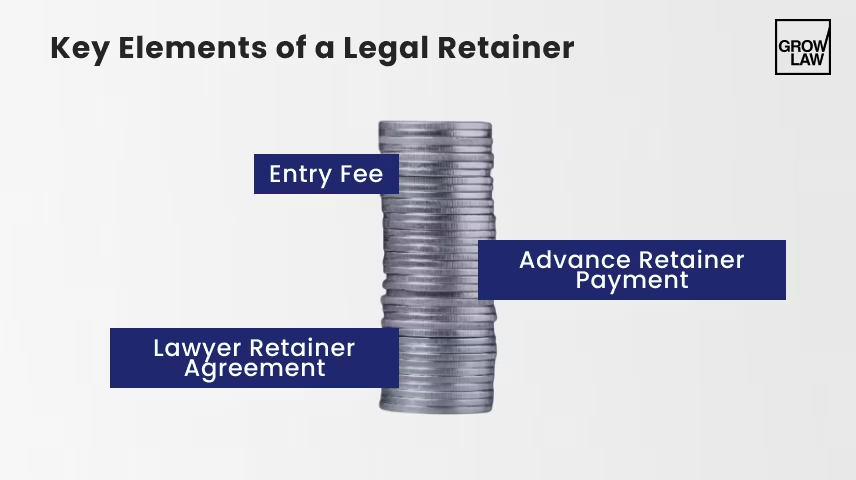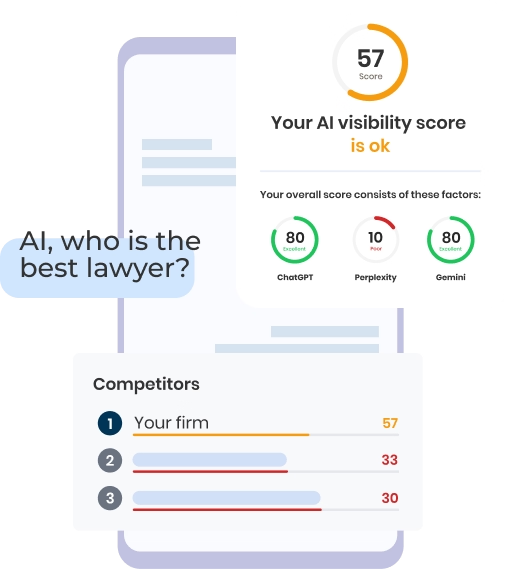Table of Contents
Ask five people what a legal retainer is. You’ll get five different answers.
“Isn’t it nonrefundable?” “Doesn’t it cover everything?” “Wait… isn’t it the contract itself?”
No, no, and no.
A retainer fee is one of the most misunderstood parts of hiring (or billing as) a lawyer. And getting it wrong can create serious headaches for both sides.
According to the American Bar Association, unclear retainer terms are among the top causes of billing disputes between lawyers and clients!
Today, we’ll break down what a legal retainer really is, how it works, and what an ethical fee structure looks like for your firm. Let's dive in.
Key Takeaways
- A legal retainer secures legal services; however, it’s not a catch-all payment.
- Structures: flat fee, hourly, or “evergreen” (refillable balance).
- Retainer ≠ retainer agreement: one’s the payment, the other’s the contract.
- Types of retainers: entry fee, advance payment, and evergreen.
- Typical cost: $500–$5,000+, depending on the case and lawyer.
What Is A Legal Retainer?
A retainer for a lawyer is an upfront payment made before any legal work begins. It’s not always the actual cost of the case — more like an initial payment that the lawyer will bill against as work is done.
So, how does a retainer for a lawyer work? The client pays a set amount, the lawyer holds it (often in a trust account), and as hours are worked or services are completed, money is taken from that balance.
Depending on the agreement, your retainer might be a flat fee, hourly billing, or an evergreen fee — i.e., an ongoing balance that’s topped up as it’s used.
Now that we've answered: "What is a retainer for a lawyer?"... let's move on to a vital distinction.
Retainer vs. Retainer Agreement: What's the Difference For a Law Firm?
Ah, the question that trips up clients and even new lawyers!
Your retainer is the money — the upfront payment that secures your time and future work.
Your retainer agreement is the document — the contract that spells out exactly what that money covers, how it’s billed, and when it must be replenished.
Keeping the two separate is vital. When clients assume the payment is the contract, it leads to confusion over refunds, trust handling, and scope.
A clear lawyer retainer agreement outlines those details in writing, preventing misunderstandings and protecting both sides before any legal services are provided.
Key Elements of a Legal Retainer
With that said, let's cover the three elements every rock-solid retainer model includes:

— Entry Fee
An entry fee is one of the most common retainer fees for law firms.
This is a lawyer's fee paid upfront that guarantees the lawyer or firm will take on the case.
P.S. This fee isn’t tied to specific billable hours or tasks; it’s paid simply to secure representation. Because you earn it upon acceptance, it’s non-refundable and not held in a trust account.
Think of it as your client’s way of saying, “I’m officially hiring you,” and the lawyer accepting the commitment before any legal work begins. When dispensing legal services, that kind of retainer fee is vital.
— Advance Retainer Payment
An advance retainer payment is basically money paid ahead of time for work that hasn’t been done yet.
These advance fees sit safely in a trust account until the lawyer actually earns them by doing the work.
Each time you complete a task or bill for hours, the corresponding amount is transferred from the trust account to your firm’s operating account.
It’s the most common way retainers are handled... fair to both sides and transparent every step of the way. Keep this in mind when you handle your law firm's retainer management!
— Lawyer Retainer Agreement
As we said before, a lawyer retainer agreement is the written contract that explains how the retainer will work.
It sets clear expectations so both the lawyer and client know exactly what’s included and what the lawyer agrees to. Every legal retainer agreement should outline:
- Services and scope: The type of work the lawyer will handle.
- Duration: How long the agreement covers the representation.
- Rates and fees: Whether it’s billing hourly, a flat fee, or a hybrid fee.
- Billable costs: What extra expenses (like filing fees or expert witnesses) may apply.
- Client payment schedule: When invoices are issued and when payment is due.
- Replenishment terms: For evergreen retainers clauses, when and how the remaining balance must be topped up.
- Invoicing and approval steps: So clients can review charges before funds move from trust to operating accounts.
A clear, well-written retainer agreement is an unsung hero in the working relationship. It leads to fewer surprises, fewer disputes, and a heck of a lot more trust on both sides.
How Does a Legal Retainer Work?
Great question! Here’s a quick look at how a typical legal retainer works from start to finish:
- The client pays the retainer.
Let’s say the client deposits $1,000 as an upfront payment. - The lawyer holds the funds in a trust account.
This ensures the money stays with the client until the lawyer earns it through actual work. - Work begins.
The lawyer completes, for example, $750 worth of billable services and sends the client an itemized invoice for review. - Funds are transferred.
Once approved, $750 moves from the trust account into the lawyer’s operating account as earned income. - Any unused funds are returned.
When the client's case wraps up, the remaining $250 is refunded to the client — or kept in trust for future work, depending on the agreement.
This system keeps billing transparent, prevents disputes, and ensures clients only pay for the work actually done. For lawyer retainer clients, that transparency is everything.
Need help streamlining client payments? Check out the top legal billing software in 2026.
Benefits Of the Retainer Model For Attorneys And Clients
A solid retainer model keeps everyone happy!
For lawyers, it means steady income, predictable cash flow, and fewer billing hassles.
For clients, it offers peace of mind, clear costs, and guaranteed access when legal help is needed.
It’s a setup built on trust and transparency. That way, lawyers stay focused on results, and clients know exactly what legal services they're paying for.
— How Lawyers Benefit from the Retainer Model
Chasing invoices isn’t why you went to law school.
That’s where retainer fees come in. They secure your time and stabilize your entire business.
- Upfront payment, upfront peace of mind: Getting paid before the work begins means no more waiting (or worrying).
- Predictable workflow: With funded matters, you can plan your calendar (and your staffing) flawlessly.
- Fewer “I thought that was included” moments: Retainer agreements spell out what’s covered, what’s not, and when to refill the balance, keeping client relationships drama-free.
- Long-term security: The only thing better than one steady retainer is ten. Consistent lead flow keeps your firm profitable and your pipeline stress-free.
When your retainer fees (and your leads) are predictable, your practice runs like a buttery smooth river. We'd even go so far as to say: implementing retainers is business-critical.
— Retainer Benefits for Clients
From a client’s point of view, a retainer goes beyond the money; it's peace of mind in advance.
- Guaranteed access: Paying a retainer secures the lawyer’s time, so when things heat up, they're first in line for help.
- No waiting, no stress: The case moves forward without delays or “I’ll get back to you” moments.
- Clear costs, no surprises: The agreement spells out what’s covered, when it’s replenished, and any extras like filing or expert fees.
- Funds stay protected: Until earned, the money sits safely in a trust account — and any unused balance is refunded, invoice by invoice.
In short, a retainer fee gives clients what they really want: access, clarity, and confidence that their case and their cash are handled right.
Lawyer Retainers Best Practices
Watch out! Even the best retainer model can backfire without the right systems. Here’s how to keep yours smooth, ethical, and client-friendly from day one.
— Communicate clearly up front
No one likes feeling like a deer in headlights when the bill arrives!
In fact, a 2026 Vanguard Communications study found that nearly 3 in 4 unhappy law clients blamed poor communication in their negative client reviews.
Even more alarming: A 2024 “secret shopper” test revealed that only 33% of firms replied to emails and 40% answered phone calls. That lack of communication is a problem.
Our advice: spell everything out early. How the retainer funds work, how much it is, what it covers, when it needs a refill, and any unique terms.
Show clients exactly how charges will appear on their invoices and when funds move from trust to your account. This dramatically increases client satisfaction.
— Offer pricing tiers
Not every client has the same budget or the same level of need. So, why treat every retainer like standard issue?
Create a few pricing tiers instead. For example:
- A basic retainer that covers a set number of billable hours each month.
- A comprehensive retainer that includes extended hours, strategy sessions, and priority access.
Many law firms use this tactic. This lets clients pick the option that fits their situation, and helps you balance your workload with predictable revenue.
Want help figuring out your ideal hours and rates? Try our Attorney Billable Hours Calculator.
— Clarify payment options
Make paying you easy. Read that again.
Let clients know exactly which payment methods you accept — whether it’s check, card, ACH, or digital payment through your client portal.
Then, clearly explain how replenishment requests work, when they’ll be sent, and how clients can top up their retainer fees securely.
The smoother you make payments, the faster your law firm gets paid, and the less time you’ll spend chasing invoices. This also makes for a far superior client experience.
— Ethics and compliance essentials (ABA guidance and refunds)
Even the greatest billing system can blow up if you skip the ethics part.
The American Bar Association (ABA) has strict rules on retainers. Here’s the quick rundown:
- Charge fairly. Fees must be reasonable for the work, not padded or inflated.
- Keep client money separate. Deposit all unearned funds into a trust account, never your operating account.
- Refund what’s not earned. Even if your agreement says “nonrefundable,” you’re still required to return unearned funds once the case ends and your legal services are dispensed.
- Check your state rules. Each state has its own spin on these regulations, so always review your jurisdiction’s bar guidelines before finalizing agreements.
Following the American Bar Association's standards keeps you compliant on a good day, and inspires more client confidence (and hence, more referrals!) on an even better day.
Your Next 100 Retainers Are Waiting — Let’s Fill Them
To make retainers work for you, you need one more thing: a steady stream of clients filling them!
Grow Law is at your service. For over 18 years, we’ve helped 100+ firms nationwide build predictable pipelines through powerful SEO, PPC, and AI-driven lead generation.
Just ask Texas Horizons Law Group — after partnering with us, they saw:
- 1,215% return on investment
- 1,300% increase in qualified leads
- 167% boost in conversion rate
- 5,250% growth in organic traffic
You, too, can have that kind of success! Ready to land your next 100 retainers?










.svg)
.svg)



